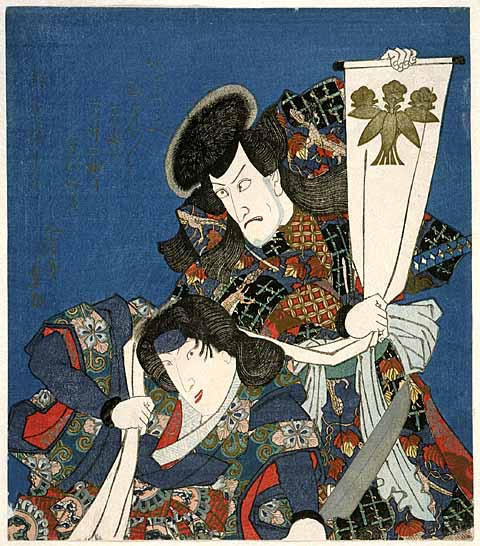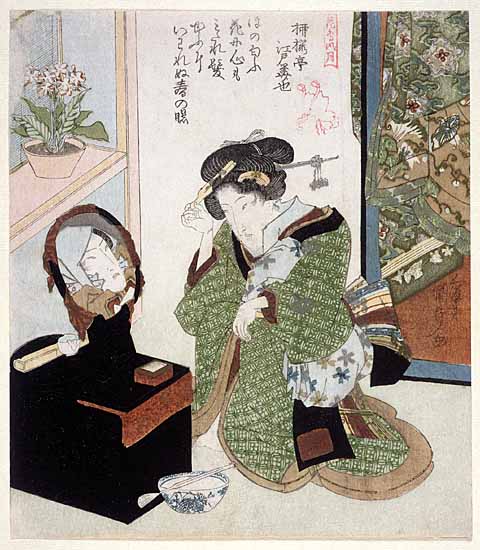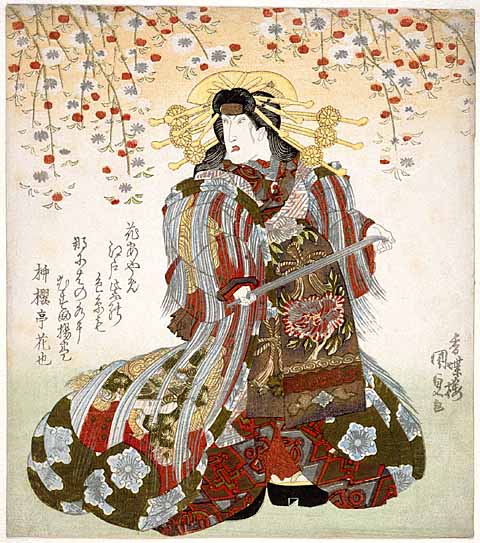Kunisada

Kunisada (1786-1865) was the most prolific and commercially-successful of all woodblock print designers. Although he designed many prints of beauties, Kabuki actors were his main speciality and formed about 70% of his output.
Part 1 of this exhibition features commercially-published actor prints from the 1820s and 30s, when Kunisada established a style distinct from that of his teacher Utagawa Toyokuni.
Part 2 comprises prints from the period after 1844 when he adopted his master’s name and signed himself ‘Toyokuni’. These later prints are more complex in design, and are shown here in ‘luxury’ impressions on thick paper with special printing effects: the reflective gleam of metallic pigments and mica; three-dimensional patterns embossed without using ink (karazuri); and shining patterns produced by burnishing the printed surface with a piece of ivory or tooth (tsuyazuri). Such costly effects were also used in the privately-issued prints known as surimono (literally ‘printed matter’), which form Part 3 of this exhibition.
Surimono combine images and poems and were often commissioned by poetry clubs associated with actors and artists, and sometimes by the actors themselves. Kunisada’s surimono were mainly produced in the 1820s and 30s and were almost entirely devoted to Kabuki subjects; several document his intimacy with leading actors such as Danjuro VII (1791-1859) and Onoe Kikugoro III (1784-1849)
Floating-world pictures (ukiyo-e)

Kabuki theatre was the most vibrant manifestation of the extraordinary ‘floating world’ of pleasure that developed under the military dictatorship of the Tokugawa shogun during the Edo period (1603-1868).
The floating world (ukiyo) centred around the Yoshiwara licensed pleasure district in Edo (now Tokyo), where samurai could step outside their normal roles in the rigid hierarchy of feudal society, and mix with the newly-wealthy urban commoners (chonin). It was the woodblock printing industry, with its technical facility to combine text and image, which gave the floating world its cohesion and spread its influence. By Kunisada’s day, the ukiyo-e print had developed into a mass-produced popular art. Commercially-published prints were issued in editions of several thousand and were relatively cheap. A normal-size (oban) print cost twenty mon, about the same as a haircut or an inexpensive meal, and about half as much as the cheapest Kabuki ticket. Kabuki fans from all strata of society could therefore buy prints of their favourite actors in the latest plays, and paste them on their walls and screens.
Accordingly the prints were nearly always published to coincide with particular performances and were intended to be sold immediately and enjoyed briefly. Yet their success was more lasting and a proportion survived in collectors’ albums. Besides the allure of the actors depicted, the prints could be appreciated on various levels. The technical finesse of the surimono and ‘luxury’ printings, and the subtle visual and literary references that cloaked modern subjects in the rich fabric of Japan’s legendary and poetic past, appealed to a discerning and sophisticated audience, including the writers, artists and actors who were leading players in the floating world.
Kabuki

Kabuki originated at the start of the Edo period and developed into an elaborate stage spectacle with complex plots and spectacular productions. Although there were also thriving theatres in Kyoto and Osaka, Edo (Tokyo) was the major centre with three licensed main theatres designated as the Edo sanza (‘Edo’s three theatres’): the Ichimura, Morita and Nakamura. Because of recurring financial problems, the Morita theatre was periodically closed (1819-22, 1823-33, 1837-56) and productions were then staged instead at the Kawarazaki Theatre. As part of the Tempo Reforms the theatres were all relocated in 1841/2 to an area near Asakusa Temple that was renamed Saruwaka Street.
The season ran from the 11th month to the 10th month. The first run of performances, from the 1st day of the 11th month to the 10th day of the 12th month, was known as the kaomise (‘face-showing’), as it introduced that theatre’s newly-engaged actors for the season. This was followed by: the new Year or early spring run (hatsuharu) starting on the 15th day of the 1st month; the main spring run (yayoi) starting on the 3rd day of the 3rd month; the satsuki run starting on the 5th day festival in the 5th month; the summer (natsu) or bon run starting on the 15th day of the 7th month at the time of the bon festival of the dead, when the main actors were on holiday and performances were undertaken by younger actors; and finally the autumn (aki) or farewell (onagori) run starting on the 9th day of the 9th month. Certain plays were linked with particular seasons for performance: the various plays telling the story of the revenge of the Soga brothers were traditionally performed at New Year (hatsuharu); Sukeroku yukari no Edo sakura (Sukeroku’s affinity for the cherry blossoms of Edo) was popular in spring (yayoi) when cherry blossoms were blooming; plays with a child separation scene such as Sugawara denju tenarai kagami (Sugawara and the secrets of calligraphy) was popular for the farewell performance in autumn (aki).
Performances continued all day, with some acts serving as comic or dance interludes (kyogen). Plays fell into two broad categories: historical tales, such as the Soga plays, and contemporary domestic dramas. Even when the story was a historical subject derived from the puppet theatre, like Sugawara denju tenarai kagami (Sugawara and the secrets of calligraphy), or from classical no drama, it was usually furnished with an amorous subplot, frequently set in the Yoshiwara. Kabuki derived many other elements from the ritual world of no, including aspects of staging, dance and stylised posture. Elaborate face make-up, wigs and costume patterns became associated with particular roles. Most plays were structured around critical dramatic moments when the individual is trapped between a merciless moral code and his or her personal feelings; the action freezes and actors literally screw themselves up to a high pitch of dramatic tension with limbs held rigid and eyes crossed. These startling poses (mie) were ideally suited for artists to capture in ukiyo-e prints.
Superstars of stage and society

In exploiting the phenomenal public fascination with professional Kabuki actors, ukiyo-e artists and publishers fanned the flames of their popularity. Together with the most exclusive prostitutes of the Yoshiwara, the actors became cultural icons, and their near-legendary names passed from one generation to another. Stars such as Danjuro VII had massive fan clubs and supplemented their huge earnings by endorsing products with their names. The ban on women performers, first enforced in 1629 to discourage licentiousness, meant that female roles, frequently intended to represent the most beautiful courtesans, had to be taken by male actors. These specialists took their female impersonations so seriously that they continued to play the part of a woman in their lives outside the theatre, going so far as to enter the women’s side of public bathhouses. Leading female impersonators (onnagata) such as Segawa Kikunojo V and Iwai Kumesaburo II became superstars, even setting trends in female fashion and influencing the way women behaved in society.
Luxury and Censorship
Despite the complete mixture of classes attending Kabuki, the hierarchical distinctions of society at large were reinforced by government censorship. In 1842 the government made an example of Danjuro VII by banishing him from Edo as a punishment for the luxurious lifestyle that he pursued in his ostentatious villa. Another decree that year was aimed at ukiyo-e print publishers:
‘To make woodblock prints of Kabuki actors, courtesans and geisha is detrimental to public morals. Henceforth the publication of new works [of this kind] as well as the sale of previously procured stocks is strictly forbidden. In future you are to select designs that are based on loyalty and filial piety and which serve to educate women and children, and you must insure that they are not luxurious.’
Accordingly the number of colour blocks in a print was restricted to eight; and the price of prints was limited to sixteen mon in order to restrain their luxury. By 1850, most of these regulations were relaxed and Danjuro VII returned to Edo. Although the letter of the law remained in force, publishers subverted it by identifying actor portraits as exemplary ‘Loyal Heroes’ or ‘Immortal Poets’ of legend. In any case, the prints played such allusive games with words and pictures that their web of meaning floated outside the control of the censors. The final years of the Tokugawa shogunate actually resulted in some of the most sumptuous prints ever designed, as the latest stars of the Kabuki stage appeared in dizzying concoctions laced with historical and literary conceits, in unprecedented combinations of high-colour printed with intoxicating effects from as many as twenty blocks. This opulence of production aptly reflects the sensational aesthetic of the Kabuki stage.
All images produced by A Morris & A Norman at the Fitzwilliam Museum.



